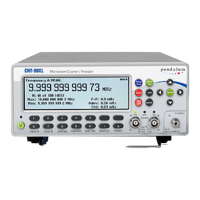Input Signaling Conditioning
Ignore Noise and
Interference
Sensitive counter input circuits are of course
also sensitive to noise. By matching the
signal amplitude to the counter's input
sensitivity, you reduce the risk of erroneous
counts from noise and interference. These
could otherwise ruin a measurement.
Narrow hysteresis gives erroneous
triggering on noisy signals.
Wide trigger hysteresis gives correct
triggering.
To ensure reliable measuring results, the coun-
ter has the following functions to reduce or
eliminate the effect of noise:
Continuously variable trigger level
Continuously variable hysteresis for some
functions
Analog low-pass noise suppression filter
Digital low-pass filter (Trigger Hold-Off)
To make reliable measurements possible on
very noisy signals, you may use several of the
above features simultaneously.
Optimizing the input amplitude and the trigger
level, using the attenuator and the trigger con-
trol, is independent of input frequency and
useful over the entire frequency range. LP fil-
ters, on the other hand, function selectively
over a limited frequency range.
The signal needs to cross the 20 mV input
hysteresis band before triggering occurs. This
hysteresis prevents the input from self-oscil-
lating and reduces its sensitivity to noise. Other
names for trigger hysteresis are "trigger
sensitivity" and "noise immunity". They ex-
plain the various characteristics of the hyster-
esis.
Erroneous counts when noise passes
hysteresis window.
Fig. 3-10 and Fig. 3-12 show how spurious
signals can cause the input signal to cross the
trigger or hysteresis window more than once
perinputcycleandgiveerroneouscounts.
USER MANUAL ● CNT 9x Series ● Rev.22 February 2020
3-6

